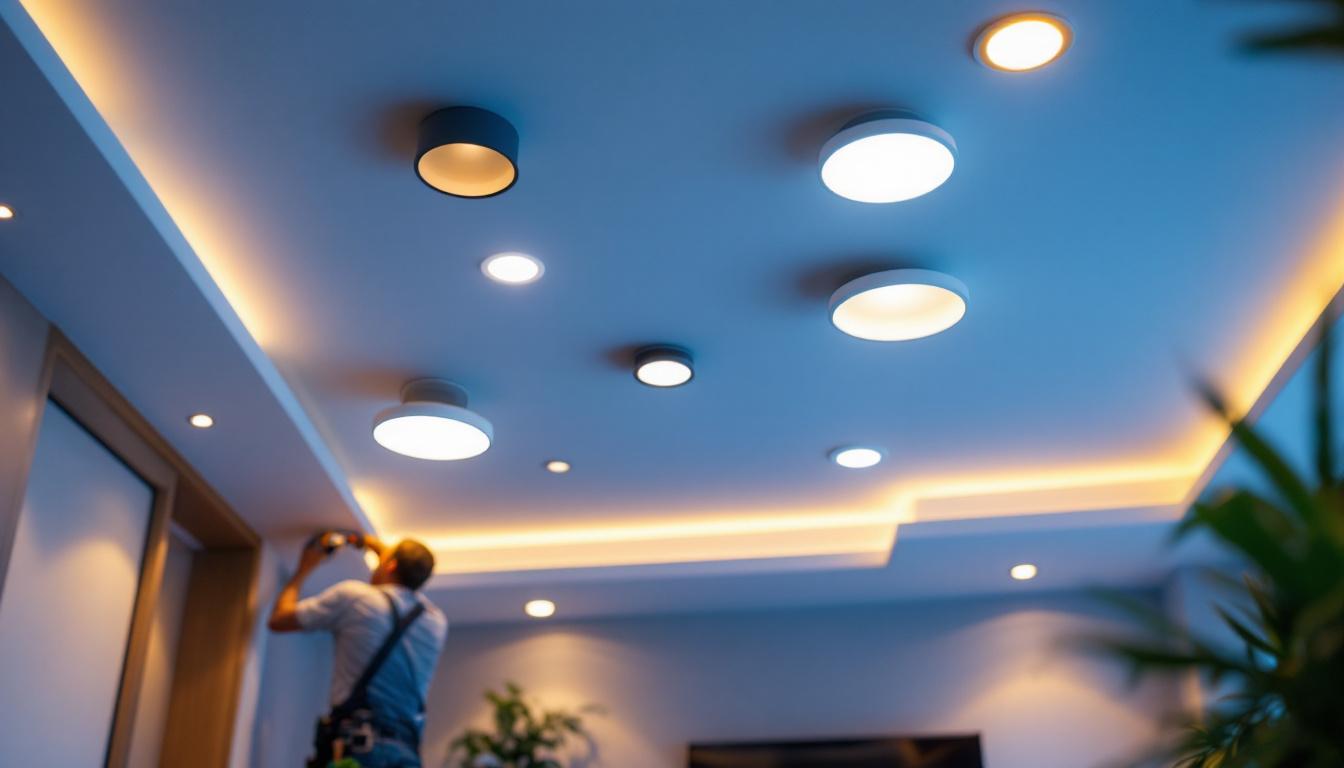
Lighting plays a crucial role in enhancing the aesthetics and functionality of a space. Among the various lighting options available, flush lights are particularly popular for ceilings due to their sleek design and ability to blend seamlessly into any environment. However, even experienced lighting contractors can make mistakes when installing flush lights. Understanding these common pitfalls can help improve the quality of work and ensure customer satisfaction.
Flush lights, also known as flush mount lights, are fixtures that are mounted directly against the ceiling. They are designed to provide ambient lighting while occupying minimal space, making them ideal for rooms with low ceilings or limited headroom. Their versatility allows them to be used in various settings, from residential homes to commercial establishments. Flush lights come in a wide array of styles, finishes, and designs, ranging from sleek and modern to more traditional and ornate options. This variety allows homeowners and designers to select fixtures that not only serve a functional purpose but also enhance the overall aesthetic of the space.
When selecting flush lights, contractors must consider factors such as the size of the room, the height of the ceiling, and the overall design theme. Choosing the right flush light can significantly impact the room’s ambiance and functionality. Additionally, the type of bulb used in the fixture can also influence the quality of light emitted. For instance, LED bulbs offer energy efficiency and longevity, while incandescent bulbs provide a warm glow that can create a cozy atmosphere. Understanding these nuances can help in making informed decisions that align with the specific needs of the space.
One of the most common mistakes lighting contractors make is selecting the wrong size of flush lights for the space. A fixture that is too small may fail to provide adequate illumination, while one that is too large can overwhelm the room’s proportions. To avoid this, it is essential to measure the room and take into account the ceiling height.
A general rule of thumb is to choose fixtures that are approximately one-third the width of the room. For instance, in a room that is 12 feet wide, a flush light fixture should ideally be around 4 feet in diameter. This guideline helps maintain a balanced look while ensuring sufficient light coverage. Furthermore, the height of the ceiling can also dictate the size of the flush light; higher ceilings may allow for larger fixtures that can draw the eye upwards, creating a more open and airy feel. In contrast, lower ceilings benefit from more compact designs that blend seamlessly with the ceiling line.
Another frequent oversight involves the placement and spacing of flush lights. Proper positioning is crucial to achieve even lighting throughout the room. Contractors should avoid clustering lights too closely together or placing them too far apart, which can create dark spots.
To ensure optimal lighting, a good practice is to space flush lights evenly across the ceiling, typically 4 to 6 feet apart. In larger rooms, additional fixtures may be required to maintain consistent illumination. Additionally, considering the room’s layout and furniture placement can help determine the best locations for the fixtures. For example, in a living room with a sectional sofa, placing flush lights over the seating area can enhance the space’s functionality, allowing for a cozy gathering spot. Moreover, dimmable flush lights can offer flexibility in lighting, enabling users to adjust the brightness according to the time of day or activity, further enhancing the room’s versatility and comfort.
Electrical work is a critical aspect of installing flush lights. Mistakes in this area can lead to safety hazards and functionality issues. It is essential for contractors to adhere to electrical codes and regulations to ensure the installation is safe and compliant.
One of the most significant errors is improper wiring. Contractors must ensure that the wiring is suitable for the load of the flush lights being installed. Using inadequate wiring can lead to overheating and potential fire hazards. It is crucial to check the wattage and voltage requirements of the fixtures and ensure that the existing wiring can handle the load.
Additionally, connections should be secure and properly insulated to prevent short circuits. Using wire nuts and electrical tape can help secure connections and enhance safety. It is advisable to double-check all wiring before sealing up the fixture to avoid any future issues.
Another common mistake is neglecting to consider the circuit load. Each circuit in a home has a maximum load capacity, and exceeding this limit can lead to tripped breakers or electrical fires. Contractors should calculate the total wattage of all fixtures on the circuit and ensure it does not exceed the recommended limits.
In cases where multiple flush lights are installed, it may be necessary to distribute them across different circuits to balance the load. This proactive approach can prevent future electrical problems and enhance the longevity of the lighting system.
The choice of bulbs used in flush lights can significantly affect the quality of light and energy efficiency. Contractors often overlook the importance of selecting the appropriate bulb type, which can lead to dissatisfaction from clients.
LED bulbs have gained popularity due to their energy efficiency and long lifespan. However, some contractors may still opt for incandescent bulbs, which consume more energy and have a shorter lifespan. It is essential to educate clients about the benefits of LED lighting, including lower energy bills and reduced maintenance costs.
Moreover, the color temperature of the bulbs can impact the room’s atmosphere. Warmer tones (2700K-3000K) create a cozy ambiance, while cooler tones (4000K-5000K) are more suitable for task-oriented spaces. Understanding the client’s needs and the room’s purpose can guide the selection of the right bulb type and color temperature.
Another oversight is failing to offer dimming options for flush lights. Dimmers allow users to adjust the brightness according to their preferences and activities, enhancing the versatility of the lighting. However, not all bulbs are compatible with dimmer switches, and contractors should ensure that the selected bulbs can be dimmed without flickering or buzzing.
Incorporating dimmable fixtures can significantly increase the appeal of the lighting system and provide clients with greater control over their environment. It is advisable to discuss these options with clients during the planning phase to ensure their satisfaction with the final installation.
The installation process is where many mistakes can occur, often due to a lack of attention to detail or rushed work. Proper techniques are essential to ensure that flush lights function effectively and safely.
Different ceiling types require different installation techniques. Contractors often overlook the specific requirements for various materials, such as drywall, plaster, or concrete. For instance, installing flush lights in a concrete ceiling may require specialized anchors or mounting brackets to ensure a secure fit.
Additionally, contractors should be aware of any insulation or structural elements that may affect the installation. Taking the time to assess the ceiling type and making necessary adjustments can prevent future issues and ensure a professional finish.
Using the wrong mounting hardware can lead to fixtures that are unstable or prone to falling. It is essential to use the appropriate anchors and screws designed for the specific weight and type of flush light being installed. Contractors should always refer to the manufacturer’s instructions for guidance on the correct hardware to use.
Furthermore, ensuring that the fixture is level during installation is crucial for both aesthetics and functionality. A crooked light can be an eyesore and may not distribute light evenly. Taking the extra time to ensure proper alignment can enhance the overall appearance of the installation.
Once the flush lights are installed, there are still several considerations that contractors should keep in mind to ensure a successful project. Post-installation checks can help identify any issues before the client takes possession of the space.
Testing the flush lights after installation is a critical step that should not be overlooked. Contractors should turn on the lights to ensure they function correctly and that there are no flickering or dimming issues. This is also the time to check for any buzzing noises that may indicate compatibility issues with the bulbs or dimmers.
If any problems arise during testing, it is essential to address them immediately rather than leaving them for the client to discover later. A thorough check can prevent dissatisfaction and enhance the contractor’s reputation for quality work.
Educating clients about their new lighting system is an essential part of the installation process. Contractors should take the time to explain how to operate dimmers, change bulbs, and maintain the fixtures. Providing clients with this knowledge empowers them to make the most of their lighting system and can lead to positive referrals and repeat business.
Additionally, offering information on energy-saving practices can help clients reduce their electricity bills and extend the lifespan of their lighting fixtures. This added value can set a contractor apart from competitors and foster long-term relationships with clients.
Flush lights are an excellent choice for providing stylish and efficient lighting in various settings. However, lighting contractors must be mindful of the common mistakes that can occur during the selection, installation, and post-installation phases. By understanding these pitfalls and implementing best practices, contractors can enhance their work quality, ensure client satisfaction, and build a strong reputation in the industry.
Ultimately, a successful flush light installation requires careful consideration of design, electrical requirements, bulb selection, installation techniques, and post-installation checks. By avoiding common mistakes and prioritizing attention to detail, contractors can deliver exceptional lighting solutions that meet their clients’ needs and exceed expectations.
Ready to elevate your lighting installations with the best selection of flush lights? Look no further than LumenWholesale, where we provide contractors with high-quality, spec-grade lighting solutions at unbeatable wholesale prices. Our extensive range of flush lights meets the highest industry standards, ensuring you deliver reliable and high-performance lighting to your clients. With free shipping on bulk orders, you can stock up on premium lighting without worrying about hidden fees or inflated costs. Make your next project shine with the perfect blend of quality, affordability, and convenience at LumenWholesale. Wholesale Lighting at the Best Value.

Discover the transformative power of handheld LED technology in this insightful article, where expert lighting contractors reveal their top tips and innovative applications.

Explore innovative strategies from expert lighting contractors on enhancing outdoor spaces with dusk till dawn lighting solutions.

Explore the rising significance of linear high bay lights in the lighting industry.

Discover essential insights from top lighting contractors in “Light Bulb: Lighting Contractors’ Quick Tips.” This article offers practical advice on selecting the right fixtures, optimizing energy efficiency, and enhancing ambiance in any space.